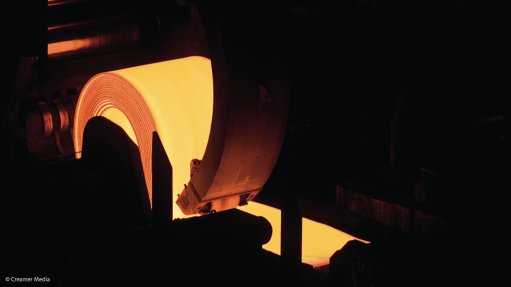
Photo by: Creamer Media
Steel group ArcelorMittal has signed an undertaking with the Spanish government in support of a €1-billion plan to construct a green hydrogen direct reduced iron (DRI) plant and a new hybrid electric arc furnace (EAF) at its facility in Gijón, in Asturias, as part of a pioneering move to transition the company’s Sestao plant, also in Spain, to a net-zero facility by the end of 2025.
The proposed development has been outlined in a memorandum of understanding, signed this week, in which ArcelorMittal indicates that its Sestao plant is set to become the world’s first full-scale steel plant to manufacture zero carbon emissions steel.
The plant manufactures a range of flat-steel products for the automotive, construction and general-industrial sectors and will produce 1.6-million tonnes of green steel yearly.
In so doing, ArcelorMittal’s Spanish operations will reduce their carbon emissions by up to 4.8-million tonnes, or half current levels, and support ArcelorMittal Europe’s target of reducing carbon emissions by 30% by 2030.
The Basque government is extending funding for the project, which will provide ArcelorMittal with access to green hydrogen supplied by a consortium of companies that will produce hydrogen using solar-powered electrolysis and distributed through a network of pipelines.
Central to the development is the construction of a 2.3-million-tonne green hydrogen DRI unit, complemented by a 1.1-million-tonne hybrid EAF, which will transition Gijón away from the blast furnace basic oxygen steelmaking production route to a DRI-EAF route.
About a million tonnes of DRI will then be transported some 250 km to Sestao yearly to be used as feedstock in its two EAFs.
Besides the Gijón projects, ArcelorMittal will invest €50-million at Sestao to introduce the other emerging technologies required to meet the net-zero objective.
The group is changing its metallic input by increasing the proportion of recycled scrap and is powering all steelmaking assets (EAFs, rolling mill, finishing lines) with renewable electricity.
ArcelorMittal South Africa, meanwhile, has indicated previously that it will consider repurposing the mothballed Saldanha Steel site to produce green iron for export, using green hydrogen.
It has reported that preliminary investigations of the options have been initiated together with the Council for Scientific and Industrial Research.
Initial research conducted for the Deep Decarbonisation Pathways project has indicated that there is an emerging opportunity for South Africa to produce green-iron material, such as hydrogen DRI, for export to international steelmakers.
The research shows that it will be cheaper to produce such DRI in South Africa, owing to the country’s “abundant and very low-cost renewable energy potential” relative to many other territories, including the European Union.